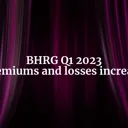Tags: Risk
This fanpage is not officially affiliated with Berkshire Hathaway: Disclaimer

In this article, we delve into the market risks faced by Berkshire Hathaway, examining the company's equity securities, interest rate risks, foreign currency risks, and commodity price risks. We also explore the historical context of Berkshire Hathaway's investments and discuss its unique approach to risk management. Finally, we offer valuable insights into the company's risk management strategy, focusing on long-term investment, concentration, and diversification.
The article on brk-b.com is based on Berkshire Hathaway's 2022 annual report.
Introduction
Berkshire Hathaway, the multinational conglomerate holding company led by the renowned investor Warren Buffett, has long been a go-to investment for many shareholders seeking long-term growth and stability. It is essential to examine the various market risks the company faces to paint a comprehensive picture for its knowledgeable shareholders.
This article aims to uncover the numbers behind Berkshire Hathaway's market risks, focusing on equity prices, interest rates, foreign currency exchange rates, and commodity prices. We will delve into the company's strategies to manage these risks and explore their implications for shareholders.
Equity Price Risk
Equity securities make up a significant portion of Berkshire Hathaway's consolidated investment portfolio. As of December 31, 2022, the fair value of these investments stood at a whopping $308,793 million. In comparison, the previous year, on December 31, 2021, the fair value was $350,719 million. This considerable exposure to equity securities leaves the company susceptible to fluctuations in equity prices, which can directly impact its bottom line.
An interesting point to note is that Berkshire Hathaway has historically concentrated its investments in a relatively small number of issuers. As of December 31, 2022, approximately 75% of the total fair value of equity securities was concentrated in just five companies. This high concentration could potentially magnify the impact of equity price movements on the company's overall financial position.
To better understand the potential effects of market price fluctuations, we can consider a hypothetical scenario in which market prices increase or decrease by 30%. In 2022, a 30% increase would have resulted in a gain of $71,344 million, while a 30% decrease would have caused a loss of $71,195 million. In contrast, in 2021, a 30% increase would have led to a gain of $81,136 million and a 30% decrease to a loss of $81,053 million. While these scenarios are purely hypothetical, they serve to illustrate the possible consequences of significant market price movements.
Equity index put option contracts also exposed Berkshire Hathaway to equity price risk in the past. However, substantially all of these contracts have since expired, mitigating this specific source of risk.
Interest Rate Risk
In addition to equity securities, Berkshire Hathaway invests in bonds, loans, and other interest rate-sensitive instruments. These investments are also subject to market risks, with changes in interest rates directly impacting their fair value. As of December 31, 2022, the fair value of fixed maturity securities held by Berkshire Hathaway was $25,128 million. On December 31, 2021, the fair value stood at $16,434 million.
To assess the potential impact of interest rate fluctuations, let's consider a hypothetical scenario in which interest rates change by 100, 200, or 300 basis points (bp). In 2022, a 100 bp decrease would have resulted in a +$491 million change in fair value, while a 200 bp increase would have led to a -$469 million change, and a 300 bp increase to a -$913 million change. In 2021, the corresponding changes in fair value would have been +$190 million, -$203 million, and -$587 million. Again, these scenarios serve to illustrate the potential consequences of interest rate movements on Berkshire Hathaway's portfolio.
Historically, interest rate fluctuations have had significant consequences for the global economy. For instance, the stagflation of the 1970s resulted from high inflation and stagnant growth, in part due to rising interest rates. Although Berkshire Hathaway has weathered various economic storms throughout its history, the company is not immune to the effects of interest rate shifts.
Foreign Currency Risk
Berkshire Hathaway's operations span across various countries, with subsidiaries in industries such as insurance, utilities, energy, and certain manufacturing and service sectors. As a result, the company is exposed to foreign currency risk as it translates the financial results of its international operations into U.S. Dollars.
In 2022, Berkshire Hathaway reported after-tax gains of $1,263 million from foreign currency transactions. In comparison, the company reported gains of $955 million in 2021. It is worth noting that Berkshire Hathaway generally does not attempt to match assets and liabilities by currency and does not use derivative contracts to manage foreign currency risks in any meaningful way.
The company's approach to foreign currency risk management is somewhat unconventional, as many multinational corporations employ various hedging strategies to mitigate the impact of currency fluctuations. However, Berkshire Hathaway's long-term investment horizon and diversified operations have historically allowed it to absorb the effects of currency shifts.
Commodity Price Risk
Many of Berkshire Hathaway's subsidiaries use commodities in manufacturing and providing services, exposing the company to commodity price risk. Fluctuations in commodity prices can directly impact the costs of production and, ultimately, the profitability of these subsidiaries.
Despite this exposure, Berkshire Hathaway generally does not utilize derivative contracts to manage commodity price risks to any significant degree. This approach is consistent with the company's long-term investment philosophy and its reliance on the diversification of its subsidiaries to absorb the impact of commodity price fluctuations.
Throughout history, commodity prices have played crucial roles in shaping economic and political landscapes. The 1973 oil crisis, for example, saw a sharp increase in oil prices due to geopolitical factors, leading to economic recessions in many countries. While Berkshire Hathaway is not immune to such events, its diversified portfolio and long-term investment strategy have helped it navigate the uncertainties of commodity markets.
Berkshire Hathaway's Risk Management Strategy
Berkshire Hathaway's approach to risk management is distinctive in its focus on long-term investment and diversification. While many companies may rely heavily on derivative contracts and other financial instruments to hedge risks, Berkshire Hathaway's strategy is more conservative and grounded in its long-term investment philosophy.
Concentration is an important aspect of Berkshire Hathaway's investment strategy, as evidenced by the fact that 75% of the total fair value of its equity securities as of December 31, 2022, was concentrated in just five companies. By concentrating on a select few high-quality investments, the company is better able to monitor and manage its exposure to market risks.
To handle interest rate risk, Berkshire Hathaway invests in bonds, loans, and other interest rate-sensitive instruments, aiming to acquire or originate such instruments at prices deemed appropriate relative to the perceived credit risk. The company also issues debt to fund business operations, acquisitions, and other general purposes. Berkshire Hathaway maintains high credit ratings to minimize its cost of debt, and while it infrequently utilizes derivative products like interest rate swaps, it does not attempt to match maturities of assets and liabilities.
For managing foreign currency risk, Berkshire Hathaway does not attempt to match assets and liabilities by currency, nor does it use derivative contracts to manage foreign currency risks in a meaningful way. This approach may expose the company to fluctuations in currency exchange rates, but its diversified operations across various industries and countries allow it to absorb the impact of currency shifts.
Regarding commodity price risk, Berkshire Hathaway generally does not utilize derivative contracts to manage these risks to any significant degree. Instead, the company relies on its subsidiaries' ability to adjust their pricing strategies and the diversification of its investments to handle the effects of commodity price fluctuations.
In conclusion, Berkshire Hathaway's risk management strategy is built on long-term investment, concentration, and diversification. The company does not rely heavily on conventional risk management techniques such as derivatives, preferring to trust in the quality of its investments and the resilience of its diversified portfolio to navigate market risks.
What did Warren Buffett say about Berkshire's risk approach back in 2019?
Conclusion
Berkshire Hathaway faces several market risks, including equity prices, interest rates, foreign currency exchange rates, and commodity prices. While the company generally does not employ conventional risk management strategies, such as using derivative contracts, its long-term investment horizon and diversified operations have allowed it to weather market fluctuations and deliver consistent returns to its shareholders.
As a shareholder it's essential to understand that the numbers we've discussed represent a snapshot in time. Berkshire Hathaway's performance and risk management strategies are subject to change, as are the broader political, economic, and historical contexts in which the company operates. As shareholders, it's crucial to remain informed and vigilant, continually assessing the company's exposure to market risks and its ability to adapt and grow in an ever-changing world.











